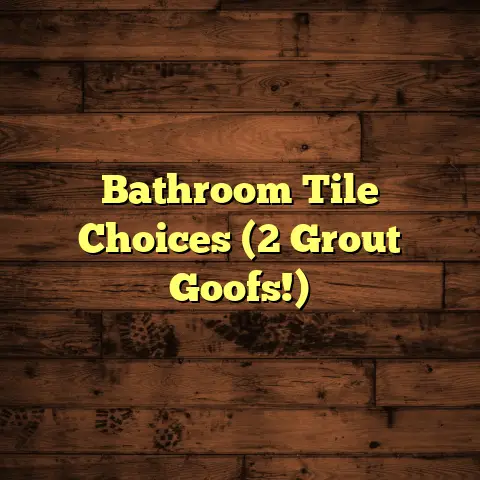Refinish Laminate Without Sanding? (1 Trick Installers Use!)
Ever run your hand across your laminate floor and felt a scratch, or noticed how the once-vibrant surface now looks dull?
It’s a common problem, and the thought of refinishing can be daunting.
I get it!
As a flooring contractor, I’ve seen countless laminate floors lose their luster.
But don’t worry, you don’t necessarily need to endure the mess and expense of traditional sanding.
Let me show you a trick we installers often use.
Imagine how great your floor will look!
Section 1: Understanding Laminate Flooring
Laminate flooring is a popular choice these days, and for good reason.
It’s made of several layers: a core board (usually high-density fiberboard), a decorative layer that mimics wood or stone, and a protective wear layer on top.
Think of it as a high-tech photo of wood, sealed under a tough shield.
This construction makes it relatively durable and affordable, giving you the look of hardwood without the hefty price tag.
Laminate floors are designed to withstand daily wear and tear, and a good quality laminate can last for 10-20 years.
But let’s be real.
Life happens!
Scratches from pets, fading from sunlight, and general wear can take their toll.
That’s where refinishing comes in.
The problem is, traditional refinishing methods aren’t ideal for laminate.
Section 2: The Traditional Refinishing Process (And Why It Sucks for Laminate)
When you think of refinishing a floor, sanding probably comes to mind.
Sanding works great for solid hardwood.
You grind away the old finish and any surface imperfections, leaving a smooth surface ready for a fresh coat of sealant.
Unfortunately, sanding laminate is a recipe for disaster.
Remember that decorative layer I mentioned?
It’s super thin.
Sanding will quickly burn through it, exposing the core board underneath.
You’ll end up with an irreparable mess, and a floor that looks even worse than before.
Chemical strippers are another option, but they can also damage laminate.
The harsh chemicals can seep into the seams and cause swelling or discoloration.
Plus, they’re messy and require serious ventilation.
Honestly, the traditional methods are time-consuming, expensive, and create a ton of dust.
No wonder many homeowners avoid them.
Section 3: The Game-Changing Trick Installers Use
So, what’s the secret?
How do installers breathe new life into laminate floors without sanding?
The answer is recoating.
Recoating involves cleaning the floor thoroughly and applying a specialized finish that bonds to the existing wear layer.
It’s like giving your floor a fresh, protective shield.
The key is using the right product.
You’ll want a laminate floor restorer or a refresher.
These products are specifically designed to adhere to the laminate surface and provide a durable, scratch-resistant finish.
They’re typically water-based and low-VOC, so they’re safer to use than traditional varnishes or polyurethanes.
The materials you’ll need are pretty simple:
- Laminate floor cleaner: A pH-neutral cleaner is best to avoid damaging the existing finish.
- Laminate floor restorer/refresher: Make sure it’s specifically formulated for laminate.
- Microfiber mop or applicator pad: These provide a smooth, even application.
- Spray bottle (optional): For applying cleaner in hard-to-reach areas.
- Painter’s tape: To protect baseboards and trim.
This method is much faster, easier, and cleaner than sanding.
Plus, it’s something you can easily DIY!
Section 4: Step-by-Step Guide to Refinishing Laminate Without Sanding
Okay, let’s get down to the nitty-gritty.
Here’s a step-by-step guide to refinishing your laminate floor without sanding:
Step 1: Prep the Area
- Remove all furniture and rugs from the room.
- Thoroughly sweep or vacuum the floor to remove any loose dirt, dust, or debris.
- Use painter’s tape to protect your baseboards and trim.
This will prevent the restorer from getting on them.
Step 2: Deep Clean the Floor
- This is crucial! The restorer needs a clean surface to bond to.
- Use a laminate floor cleaner and a microfiber mop to thoroughly clean the floor.
- Follow the instructions on the cleaner bottle.
- For stubborn spots, you can use a soft-bristled brush.
- Make sure to rinse the floor thoroughly with clean water to remove any cleaner residue.
- Let the floor dry completely before moving on to the next step.
This could take a few hours.
Step 3: Apply the Laminate Floor Restorer
- Read the instructions on the restorer bottle carefully.
- Shake the bottle well before use.
- Pour a small amount of restorer onto the floor.
- Using a microfiber mop or applicator pad, spread the restorer evenly over the surface.
- Work in small sections, overlapping each stroke slightly to avoid streaks.
- Avoid applying too much restorer, as this can lead to a cloudy or uneven finish.
- Pay attention to the edges and corners of the room.
Step 4: Let it Dry (Patience is Key!)
- Allow the restorer to dry completely.
- This usually takes 24-48 hours, depending on the product and the humidity.
- Avoid walking on the floor during this time.
- You may need to apply a second coat for added protection and shine.
- If so, repeat steps 3 and 4.
Step 5: Admire Your Handiwork
- Once the restorer is completely dry, remove the painter’s tape from the baseboards and trim.
- Replace the furniture and rugs in the room.
- Stand back and admire your newly refinished laminate floor!
Tips for the Best Results:
- Test in an inconspicuous area: Before applying the restorer to the entire floor, test it in a closet or under a piece of furniture to ensure it doesn’t discolor the laminate.
- Apply thin, even coats: Multiple thin coats are better than one thick coat.
- Avoid direct sunlight: Direct sunlight can cause the restorer to dry too quickly, leading to streaks.
- Ventilate the room: Open windows and doors to provide adequate ventilation.
- Don’t overwet the floor: Excess moisture can damage the laminate.
Section 5: Success Stories and Testimonials
I’ve seen this trick work wonders for homeowners.
Take my friend Sarah, for example.
Her laminate floor was looking tired and scratched after years of kids and pets.
She was dreading the thought of replacing it.
I suggested she try recoating.
She followed these steps, and the results were amazing!
Her floor looked brand new.
She saved a ton of money and avoided the hassle of a full replacement.
Or consider this testimonial from a client:
“I was skeptical at first, but I was amazed at how easy it was to refinish my laminate floor without sanding.
The restorer filled in the scratches and gave the floor a beautiful shine.
It looks like I have a new floor!” – John D.
Before and after photos really tell the story.
You can see how the restorer fills in scratches, evens out the color, and adds a protective layer that makes the floor look fresh and vibrant.
The best part? The satisfaction of knowing you revived your floor yourself!
Section 6: Maintenance Tips for Longevity
Once you’ve refinished your laminate floor, you’ll want to keep it looking its best.
Here are some maintenance tips:
- Regular Cleaning: Sweep or vacuum the floor regularly to remove dirt and debris.
Use a laminate floor cleaner and a microfiber mop for deeper cleaning. - Avoid Harsh Chemicals: Don’t use abrasive cleaners, bleach, or ammonia, as these can damage the finish.
- Use Doormats and Rugs: Place doormats at entrances to trap dirt and debris.
Use rugs in high-traffic areas to protect the floor from wear. - Trim Pet Nails: Keep your pet’s nails trimmed to prevent scratches.
- Use Furniture Pads: Place felt pads under furniture legs to prevent scratches and dents.
- Clean Up Spills Immediately: Wipe up spills as soon as they happen to prevent staining or water damage.
- Avoid Excess Moisture: Don’t overwet the floor when cleaning.
- Consider a Maintenance Coat: Every year or two, you may want to apply a fresh coat of laminate floor restorer to maintain the shine and protection.
Addressing minor scratches and damage promptly can prevent the need for future refinishing.
You can use a laminate floor repair kit to fill in small scratches or chips.
Conclusion
So, there you have it!
Refinishing laminate without sanding is not only possible, but it’s also a relatively easy and affordable way to breathe new life into your floors.
With the right knowledge and technique, you can transform your space and enjoy a beautiful, vibrant floor for years to come.
Imagine the feeling of walking into your home and being greeted by a floor that looks fresh, clean, and inviting.
It’s a simple change that can make a huge difference in the overall look and feel of your home.
Now, go forth and revitalize those floors!
You’ve got this!





